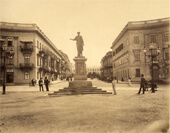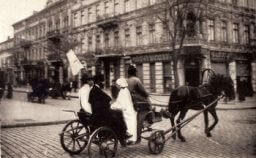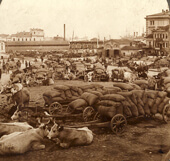Charles King Speaks About his Book
This is a book about a city in Ukraine, a country that few people know much about. Why did you write it?

The book has a mystery story at its core: how a cosmopolitan city of many nationalities and religions managed to thrive for so long but then nearly destroy itself during the Holocaust. About a third of the city’s population was Jewish by the early 1940s. Yet by 1944, there were only a few dozen Jews left there. Many Jewish-Americans—as well as Russians, Ukrainians, Greeks, and Italians—can trace their family roots to Odessa. Even beyond those family ties, lots of other people know Odessa by reputation: as a haven for men-on-the-make, con artists, and creative crooks. The book weaves together the story Odessa’s rise as a boomtown in the nineteenth century with the lives of the many heroes, artists, and writers who made the city famous.
Who are some of the heroes—or villains?

Some of the heroes are world-famous. The Russian national poet, Alexander Pushkin, spent time in the city and fell in love with the wife of the local governor, a woman who became the inspiration for Pushkin’s famous novel-in-verse Evgeny Onegin. The Russian-Jewish author Isaac Babel was born in Odessa. He immortalized the city’s seamier side in his Odessa Tales, wonderful sketches of gangsters, prostitutes, and bent cops in the city’s main Jewish neighborhood. His contemporary, the director Sergei Eisenstein, shot his most important film, Battleship Potemkin, on the famous “Potemkin steps” that lead from the city center to the harbor. Other characters in the book are less well-known, such as Gheorghe Alexianu, a Romanian professor who presided over the destruction of the city’s Jewish community during the Holocaust, or the scientist Ilya Mechnikov, for whom Odessa’s disease-ridden port became a laboratory for his Nobel-prize-winning work in immunology.
The title mentions “genius and death.” Why did you choose those terms?

a-oMark Twain visited Odessa in the 1860s and compared it to America: a place with lots of ambitious and talented people on the move, trying to build something from scratch. Odessa was founded in 1794—which makes it younger than Washington, DC—and raising it up out of the Ukrainian steppe demanded a kind of genius. It thrived because, as a boom town built on the wheat trade, it tended to attract people of skill and ingenuity. Over time, it garnered the reputation for producing and inspiring geniuses, too—people like Pushkin, Babel, and others. But death was also an ever-present feature of Odessa’s urban life. The bubonic plague repeatedly ravaged the city. Stories of murder, suicide, and executions for political crimes sometimes shocked the Russian Empire. In the twentieth century, Odessans repeatedly turned on one another—from the wrenching anti-Jewish pogrom of 1905, which made headlines across Europe, to the devastation of the Holocaust.
What is the high point of the book?

The book’s high point—or low point, in fact—comes in the early 1940s, when the city was occupied by Romania, then an ally of the Nazis. In one of the untold chapters of the Holocaust, the city’s Jewish population was nearly destroyed by the Romanian occupation forces. People were literally hanged in the streets in the largest instance of wartime killing committed by a country other than Nazi Germany. In researching the book, I uncovered hundreds of new archival documents, and I used those to piece together Odessa’s experience of war, occupation, and genocide.
Does Odessa’s story have any lessons to teach?
Odessa’s predicament turns out to be that of many multicultural cities: the constant struggle to be diverse without tipping over the edge into social disorder. Odessans are immensely patriotic about their city, and even people who have left to live in places like Brighton Beach, Brooklyn—often known as “Little Odessa”—can wax nostalgic about their old homeland. But the reality is that Odessa has repeatedly turned in on itself, fighting against the multiculturalism that has long defined it. The book isn’t pessimistic about the possibility of people of many cultures and languages living together in peace. But it does show that multiculturalism takes work. When we take it for granted, the dark forces of envy, suspicion, and mutual antagonism can win out.
